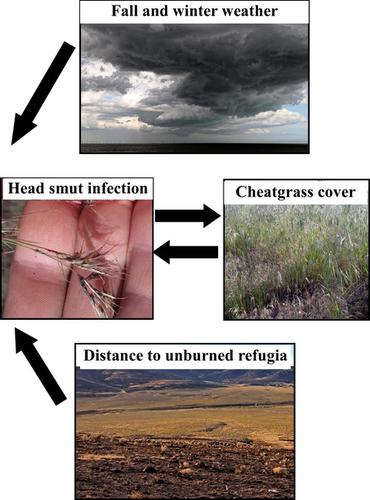Our official English website, www.x-mol.net, welcomes your feedback! (Note: you will need to create a separate account there.)
Weather and distance to fire refugia limit landscape‐level occurrence of fungal disease in an exotic annual grass
Journal of Ecology ( IF 5.5 ) Pub Date : 2021-03-03 , DOI: 10.1111/1365-2745.13638 Cara Applestein 1 , Allison B. Simler‐Williamson 1 , Matthew J. Germino 1
中文翻译:

天气和到火避难所的距离限制了一年生异国草丛中真菌病在景观水平上的发生
更新日期:2021-05-12
Journal of Ecology ( IF 5.5 ) Pub Date : 2021-03-03 , DOI: 10.1111/1365-2745.13638 Cara Applestein 1 , Allison B. Simler‐Williamson 1 , Matthew J. Germino 1
Affiliation

|
- The enemy release hypothesis proposes that invasion by exotic plant species is driven by their release from natural enemies (i.e. herbivores and pathogens) in their introduced ranges. However, in many cases, natural enemies, which may be introduced or managed to regulate invasive species, may fail to impact target host populations. Landscape heterogeneity, which can affect both the population dynamics of the pathogen and the susceptibility and the density of hosts, may contribute to why pathogens fail to control hosts despite established negative disease impacts.
- We explored patterns of post‐fire infection of the fungal head‐smut pathogen Ustilago bullata on the invasive annual cheatgrass Bromus tectorum, which has caused the notorious grass‐fire cycle and ecosystem degradation across Western North America. We asked whether infection level was a driver of host density or vice‐versa, and how weather affected infection and how spatial patterns of infection varied with time since fire, using a combination of structural equation modelling (SEM), proportional odds modelling and entropy‐based local indicator of spatial association (ELSA) on data from >700 plots spanning >100,000 ha remeasured annually for 4 years.
- Observed infection levels increased with greater prior‐year cheatgrass cover, and disease severity did not suppress cheatgrass populations. Warm, humid fall/winters and proximity to fire refugia (unburned patches) were associated with more infections. Infection clustering was most evident 2–3 years following fire with warm‐wet fall–winter conditions and decreased after two drier, colder winters.
- Synthesis. Severity of fungal disease did not result in measurable reductions of populations of a non‐native, invasive host species, cheatgrass, which suggests that natural enemies may not strongly regulate cheatgrass in its introduced range. Landscape heterogeneity associated with disturbance and weather limited population‐level infection of hosts by the fungal pathogen. Disturbance (specifically wildfire) and variable weather are key components of this and similar invasion systems, and likely need to be considered when evaluating disease dynamics and potential for natural enemies to influence invasion potential.
中文翻译:

天气和到火避难所的距离限制了一年生异国草丛中真菌病在景观水平上的发生
- 敌人释放假说提出,外来植物物种的入侵是由它们在引入范围内从天敌(即食草动物和病原体)释放而驱动的。但是,在许多情况下,可能被引入或设法控制入侵物种的天敌可能不会影响目标宿主种群。景观异质性既会影响病原体的种群动态,又会影响寄主的易感性和密度,这可能会导致为何病原体尽管建立了负面的疾病影响但仍无法控制寄主。
- 我们探索了侵染性一年生无芒草无尾目(Bromus tectorum)上真菌性黑曲病病原体大头孢菌(Ustilago bullata)的火后感染模式,这种模式导致了整个北美西部臭名昭著的草火周期和生态系统退化。我们使用结构方程模型(SEM),比例优势模型和熵的组合来询问感染水平是否是宿主密度的驱动因素,反之亦然,以及天气如何影响感染以及自火灾以来感染的空间模式如何随时间变化-基于空间关联性本地指标(ELSA)的数据,该数据来自于700多个面积超过100,000公顷的地块,每年进行4年的重新测量。
- 观察到的感染水平随着前一年的无茅草覆盖率的增加而增加,疾病的严重程度并未抑制无茅草种群。温暖,潮湿的秋/冬和接近火re病(未烧伤的斑块)与更多的感染有关。着火后的2-3年,秋冬季温暖湿润,感染聚集最明显,而在两个更干燥,更冷的冬天后,感染聚集减少。
- 综合。真菌病的严重程度并未导致非本地入侵物种雪草的种群数量显着减少,这表明天敌可能不会在其引入范围内强烈调节雪草。与真菌病原体干扰和天气相关的景观异质性限制了宿主的宿主水平感染。干扰(特别是野火)和多变的天气是此入侵系统和类似入侵系统的关键组成部分,在评估疾病动态和天敌影响入侵潜力的潜力时,可能需要考虑这些因素。


























 京公网安备 11010802027423号
京公网安备 11010802027423号